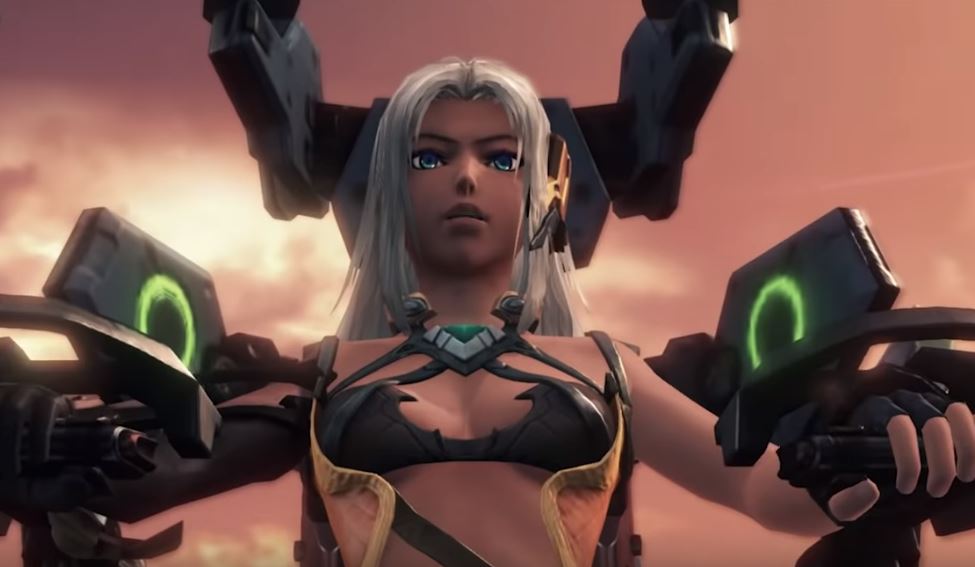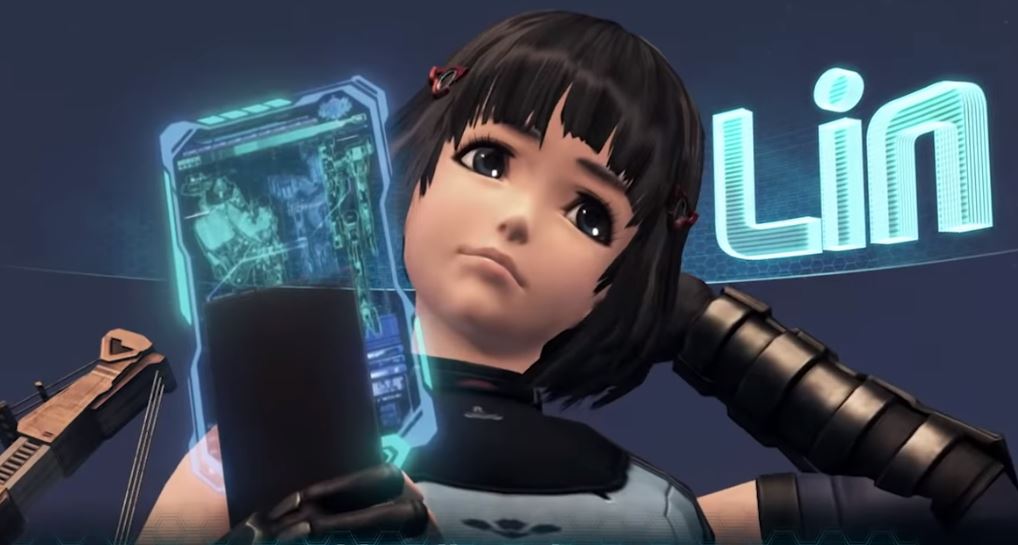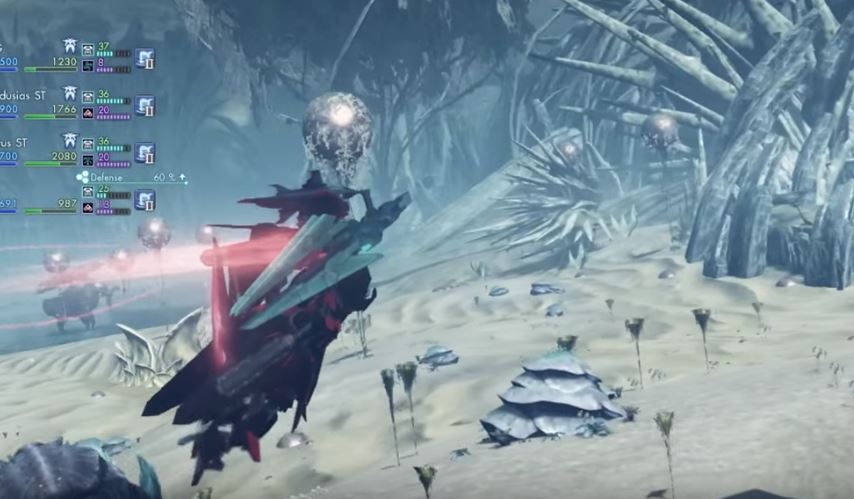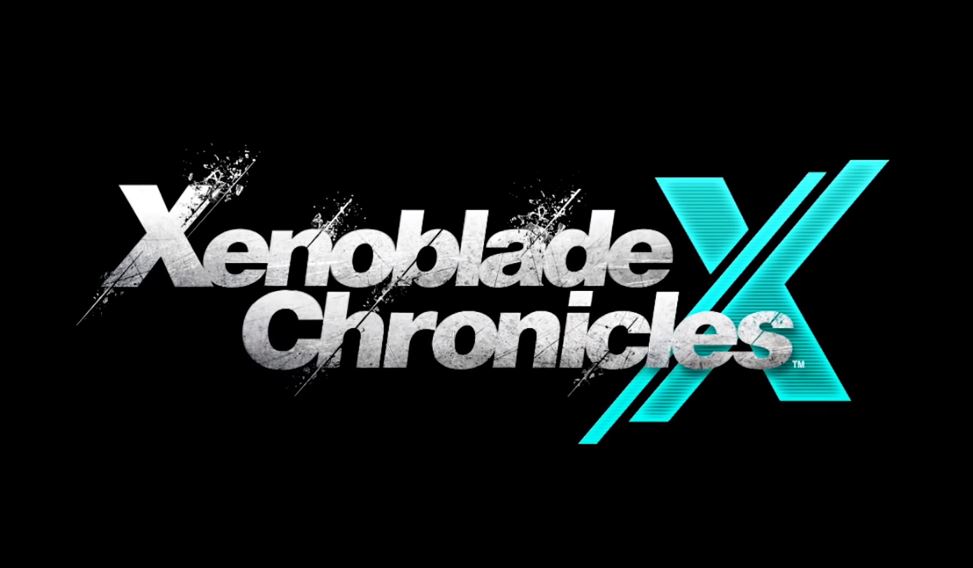Xenoblade Chronicles X is a mixed bag of amazing experiences and frustrating game design. Like the first game this one is absolutely worth playing, but it has some problems. I spent over 100 hours playing Xenoblade Chronicles X, so those problems aren’t deal breaker. They’re worth acknowledging, but I will whole heartily recommend this game to any WiiU owner. It’s my favorite game on the system.
Before diving into the review proper, I must clarify that Xenoblade Chronicles X is not a sequel to the story of Xenoblade Chronicles. Much like the Final Fantasy, the games share game play and thematic elements. Species, character names and enemy types may be the same; but these are more connective threads and homages than the indication the stories are related. There’s no need to have played the first game to enjoy this one.
Surviving Mira
War rages between two alien species, while Earth remains an innocent bystander. Humanity knows the world is in the line of fire, and working together they plan an escape. Earth is destroyed in the conflict, but humanity develops space ships and flees just in time. The White Whale is one of the ships that escapes the destruction unscathed. Two years of flying through empty space, the White Whale is attacked by an alien ship and crash lands on Mira.
The main character awakes from suspended animation months after the crash. Elma, one of the most capable defenders of humanity on Mira, finds your escape pod undamaged and re-activates you. You and all humans have robotic bodies, called Mimeosomes, while their physical being is held in a lost piece of the White Whale called the Lifehold. Humanity’s thoughts are transmitted from the Lifehold to the mimeosomes, but there is a limit to the power transfer. 30 days remain before power will run out, and all mimeosomes shut down. 30 days until humanity dies.
Finding the Lifehold and surviving on Mira are simple goals that drive Xenoblade Chronicles X. Surviving means defending against violent local creatures, locating resources across Mira, and fighting alien enemies that crashed alongside the White Whale. There’s plenty of smaller tasks, but these are the main gameplay elements and each are tied directly to the narrative. This synthesis between gameplay and story remains a strength of the series.
Mira is home to a plethora of alien life forms. Some native to the planet, while others crashed here like the humans. After the destruction of Earth, much of humanity are xenophobic, but working with the aliens becomes key to humanity’s survival on Mira. Quests involving the aliens further connects gameplay and narrative.
Characters and Plot make a Story
Character creation is rare in JRPGs, but Xenoblade Chronicles X has the player create a unique avatar. Story driven JRPGs are typically a linear affair, and custom characters affect how a narrative plays out. The story needs to account for an almost infinite variety of character types. This problem is solved by making the player a secondary character in the story. Their avatar is an observer, only occasionally influencing decisions at key points, but is never fleshed out.

Elma and Lin are the main characters of Xenoblade Chronicles X. The duo complete your party. Eventually the player can swap in other characters if they wish, but Elma and Lin are required for the major story beats and will likely never leave most players party setup. The other characters provide little enhancement to combat and essentially no story impact, so they’re best ignored.
Elma is a driven, competent military leader. Always acting in the best interest of humanity, her decisions are predictable in their earnestness. She has no character arc. Who she is at the beginning of the game is the same at the end. The only development she gets is cosmetic, literally skin deep. It doesn’t change her character at all.
This isn’t to say Elma is a bad character. Superman, Batman and many superheroes lack a character arc. They remain largely unchanged, but they still impact the story and development. Elma’s a fine character, you root for her to succeed. Just don’t expect her to change as the story progresses. She will remain Elma.
Lin gets more development, but I hesitate to call it a complete character arc. Throughout the game, she learns that humanity’s escape from Earth involved a lot of morally grey decisions to accomplish. Lin’s a genius mechanic, but she’s also a bubbly teenage girl. Her coming to grips with the reality of compromise that allowed humanity to escape annihilation is strong character work. Unfortunately, it doesn’t impact her personality much. You don’t see that realization impact her on a grand level. A missed opportunity.
I nearly forgot about the party’s last member. Tatsu is a Nopon merchant who worms his way into the party. Nails on a chalkboard are less irritating than Tatsu’s voice. Riki occasionally annoyed me, but he had good character moments. Tatsu never adds anything fun or interesting to the story or gameplay. He’s superfluous. The only thing to like is a joke Lin makes about mistaking Tatsu for food and wanting to ear him. It’s funny, but sadly the joke comes up time and time again until you wish she would eat him and get it over.

Elma and Lin are serviceable characters. The same can be said about the plot, its serviceable. The aliens who destroyed Earth and attacked the White Whale crashed on Mira too. While searching for the Lifehold your party discovers them, and conflict ensues. The fight with the aliens isn’t particularly engaging. We learn a bit about their motivations in attacking the White Whale, but it’s the old trope that they see humanity as a cancer to the universe. Nothing revolutionary or even a fun twist on a classic.
There are amazing moments in that conflict. The attack on humanity’s stronghold, New LA, by the aliens is incredible. Large scale combat is usually reserved for cut scenes in JRPGs, but here you’re plunged right into the thick of it. This is Xenoblade’s Normandy beach. It’s an epic moment that the rest of the game can’t trump. Even the finale, which is great in its own right, falls short.
Scattered throughout the game are quests that flesh out characters. Adding depth to side characters is a nice narrative touch, but these are optional side quests. Many of them are easy to miss. This setup means many great moments aren’t spotlighted for players. It’s a shame, because if they were included in the main quest it would improve the game.
Characters and plot are acceptable. They help drives the gameplay and it does enough to keep players invested. Xenoblade Chronicles X won’t blow your mind on this front, but it won’t disappoint.
Combat refined
While story gets a downgrade, the combat refines and improves over the original game. The basics remain the same, with automated attacks while players focus on arts and character positioning. Quick-time button events give characters a boost to their abilities. The basic elements remain the same, but each are improved upon.

Auto Attacks now include short and long-range weapon switched between at will. Long-range rifles are weaker, but fire multiple times from a distance. Short range weapons strike harder, but only hit once per attack. Bullets are more effective against some enemies, while melee weapons work on others. Switching between the two keeps players on their toes while waiting for Arts to cool down.
Arts still consist of physical attacks and assistance buffs. Leveling Arts improves their ability and reduces cool down time. Combining Arts creates effective combos and remains essential to defeating enemies. Adding to Arts strategy is a second cool down counter that takes longer to complete, but amplifies the Art’s power. Do you wait for the added power or attack the enemy right away with a combo? This simple addition greatly expands combat strategy.
Combat requires players to pay strict attention to what is happening. The active battle system is complex, and with soul voices and overdrive options that enhance protection and combat ability; there’s tons of options available to you. Every change made to combat for X is an improvement.
Adventuring across and over Mira
Bionis and Mechonis are breath taking. Uniquely creative, adventuring across giants is special. Mira’s five continents are larger, and packed with far more flora and fauna, but even so it fails to surpass the first game’s impressive world setup. Thankfully, Mira does make for a more interesting open world design to explore. The setup isn’t as compelling, but as a function of game play Mira offers more to players.

Five continents make up the total landmass of Mira, and the whole thing can be explored without a load screen. Every corner turned or hill crested reveals three new points of interest. It’s absolutely massive, and filled with gameplay experiences. Bionis felt empty at times, a reflection of the underpowered Wii hardware, but Mira’s packed with creatures to fight and place to explore. It’s among the best open worlds in videogame history, right up there with Hyrule in Breath of the Wild.
Around the 25 hour mark, explore Mira gets even better as the Skells are unlocked. Skells are giant flying mech suits, just as awesome as it sounds. Flying from the streets of New LA to the far corners of Mira gives a whole new perspective on the game world, literally as you see it from far above. What looked like unreachable mountain tops becomes a whole new area to explore. Anywhere you can see you can visit with a Skell.
I’ve heard complaints about how late into the game Skells are opened. Personally I found it an intelligent design choice. Exploring Mira on foot provides players a strong understanding of each area’s geography. Once you reach the point of having a Skell, most players will have explored most of Mira and gotten comfortable with what it offer. Adding flight tears that familiarity away, driving a renewed interest in exploration. It’s a brilliant build up that the game needed. Flying from minute one would make Mira feel small, instead of bigger the way it works in the game proper.
Systems remain a struggle
One of my biggest gripes with the first Xenoblade game was the quest tracker and navigation system. Unfortunately, these remain a problem in X. Tracking quests is far more work than it should be. Navigating with the map is improved, but it’s still imprecise. The only system tool that works well is the map screen on the WiiU controller. Showing areas of interest and resource opportunities, it helps guide players, but never feels as useful as it could be.
Resource collecting is another annoyance. Scattered around Mira are collection points, which provide resources and can be leveled up for better collecting. Failing to optimize resource gathering does little to impact the game, so investing in the frustrating system feels wasteful. I did the bare minimum and focused on exploration and combat.
Picturesque Mira
WiiU may have been under powered next to PS4 and Xbone, but it blows the Wii away. Xenoblade Chronicles X is no slouch in the graphics department. It can’t compare to current releases, but flying over the mass amount of enemies and creatures in a Skell is a wondrous experience. The art design of Mira captivates, drawing you into the world and encouraging exploration. You want to see what the world looks like from all angles, because it’s beautiful and you’ll find hidden game play elements.

Primodria’s green fields and skyscraping rock spires are a perfect introduction to Mira. Noctilum ‘s spider filled jungle takes giant trees to a new level. Oblivia’s desert landscape it dotted with massive rings of alien origin, combining the familiar and foreign. Cauldaros is a nice volcanic area, but sadly stands as the least interesting of the continents. Sylvalum’s stark white fields and rock faces are entirely alien, and it’s easily my favorite of the continents to explore.
The soundtrack is largely fantastic, with a few notable exceptions. The theme for New LA, where you’ll spend a lot of time, is bizarre. Do I like it or hate it? Still not sure. The lyrics are absolute non-sense, and the beat’s strange. None of it quite works, but it doesn’t make my ears bleed. Maybe I don’t like it, if that’s the best compliment I can manage for the New LA theme.
The rest of the soundtrack is fantastic, especially the 80s styled technobeat of “Don’t Worry” while flying in a Skell. The lyrics talk about being over the rainbow, which fits flying through an alien sky. The singer does a lovely job, and her vocals match the music. It feels like a classic 80s adventure theme. Think an electronic version of the Neverending Story theme song.
WiiU’s Flawed Jewel
Xenoblade Chronicles X is my favorite WiiU game despite its problems. Combat is absolutely amazing. Exploring Mira is captivating. The design of the environments keeps pulling you in new directions. There’s always something to discover or fight. Character and plot are good, and they always do the job of pushing you to explore more of the world. That synthesis between narrative and game play is a real strength for Xenoblade Chronicles X. This is hands down the best game on the WiiU.
Xenoblade Chronicles X Review
Summary
Pros
Mira’s design is perfection
Refined combat system
Flying a Skell over Mira
Cons
Questing remains problematic
Story is okay at best
Tatsu melts my mind
Buy a WiiU for this one!

